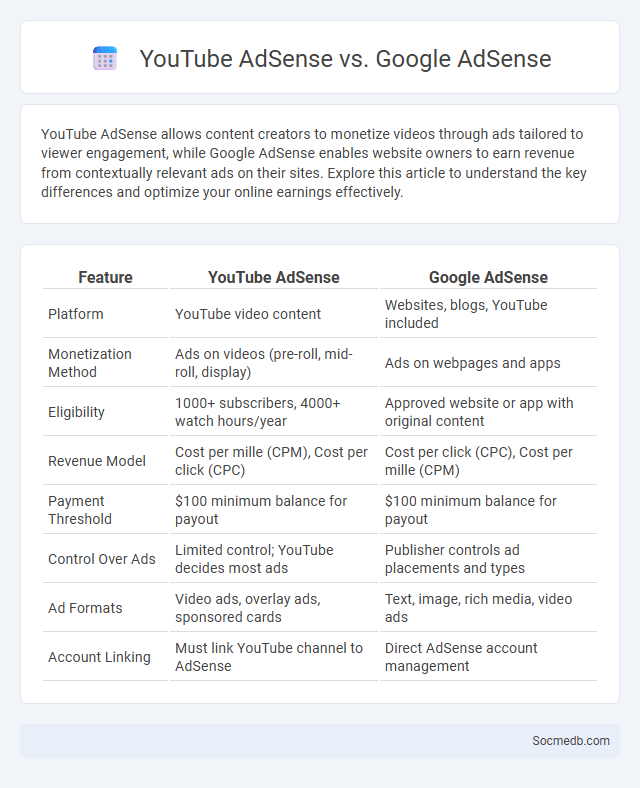
Photo illustration: YouTube AdSense vs Google AdSense
YouTube AdSense allows content creators to monetize videos through ads tailored to viewer engagement, while Google AdSense enables website owners to earn revenue from contextually relevant ads on their sites. Explore this article to understand the key differences and optimize your online earnings effectively.
Table of Comparison
| Feature | YouTube AdSense | Google AdSense |
|---|---|---|
| Platform | YouTube video content | Websites, blogs, YouTube included |
| Monetization Method | Ads on videos (pre-roll, mid-roll, display) | Ads on webpages and apps |
| Eligibility | 1000+ subscribers, 4000+ watch hours/year | Approved website or app with original content |
| Revenue Model | Cost per mille (CPM), Cost per click (CPC) | Cost per click (CPC), Cost per mille (CPM) |
| Payment Threshold | $100 minimum balance for payout | $100 minimum balance for payout |
| Control Over Ads | Limited control; YouTube decides most ads | Publisher controls ad placements and types |
| Ad Formats | Video ads, overlay ads, sponsored cards | Text, image, rich media, video ads |
| Account Linking | Must link YouTube channel to AdSense | Direct AdSense account management |
Introduction to YouTube AdSense, Google AdSense, and Ad Revenue
YouTube AdSense is a powerful platform that enables content creators to monetize their videos through Google AdSense by displaying targeted ads, generating ad revenue based on viewer interactions. By linking your YouTube channel with Google AdSense, you unlock the potential for steady income streams as advertisers pay per click or impression on your ads. Understanding the dynamics of ad placement, viewer demographics, and CTR (click-through rate) can significantly enhance your ad revenue optimization strategy.
What is YouTube AdSense?
YouTube AdSense is a monetization program that allows content creators to earn revenue by displaying ads on their videos. It operates through Google AdSense, which places targeted advertisements based on viewers' demographics and interests, maximizing revenue potential for creators. This program is crucial for YouTubers seeking to generate income through video content by leveraging ad impressions and clicks.
What is Google AdSense?
Google AdSense is an advertising program that allows website owners to earn revenue by displaying targeted ads on their social media platforms, blogs, or websites. By integrating Google AdSense, you can monetize your content through automatic ad placements tailored to your audience's interests. This service provides detailed performance reports to help optimize your earnings and improve ad relevance.
Key Differences Between YouTube AdSense and Google AdSense
YouTube AdSense primarily monetizes video content through ads displayed on creators' videos, using metrics such as views, watch time, and engagement to determine revenue. Google AdSense serves ads across various websites and platforms, relying on page views and clicks for income generation. The key difference lies in YouTube AdSense's integration with video content and audience retention, whereas Google AdSense focuses on broader website traffic and contextual ad placement.
How Ad Revenue Works on YouTube
YouTube generates ad revenue primarily through its Google AdSense program, where advertisers bid to display ads on videos based on viewer demographics and content relevance. Content creators earn a share of this revenue, typically receiving 55% of ad earnings while YouTube retains 45%. Factors influencing ad revenue include watch time, viewer engagement, ad formats like skippable and non-skippable ads, and the geographic location of the audience.
How Ad Revenue Works on Websites and Blogs
Ad revenue on websites and blogs is generated through various models such as pay-per-click (PPC), cost-per-impression (CPM), and affiliate marketing, which monetize your content by displaying targeted advertisements to visitors. Advertisers use data analytics and user behavior tracking to optimize ad placements, ensuring higher engagement and increased earnings for your platform. Understanding how ad networks like Google AdSense or Mediavine function can help you maximize your site's revenue potential effectively.
Earning Potential: YouTube vs Websites
YouTube offers significant earning potential through ad revenue, sponsored content, and channel memberships, leveraging its massive user base and algorithm-driven visibility. Websites generate income via diverse monetization methods such as affiliate marketing, display ads, and direct product sales, providing you with greater control over branding and audience targeting. Choosing between YouTube and websites depends on your content strategy, audience engagement preferences, and long-term revenue goals.
Eligibility and Requirements for Each Platform
Each social media platform has unique eligibility criteria and requirements that you must meet to create an account. For instance, Facebook requires users to be at least 13 years old and comply with its community standards, while Instagram also demands a minimum age of 13 alongside adherence to its content guidelines and privacy policies. Understanding the terms of service, verification processes, and age restrictions of platforms like LinkedIn, Twitter, and TikTok is essential to ensure your account remains compliant and active.
Pros and Cons of Using Each Ad Platform
Facebook offers precise audience targeting and extensive user engagement but may face challenges with ad fatigue and privacy concerns. Instagram excels in visual storytelling and influencer marketing, yet its ad costs and algorithm changes can limit reach for small businesses. LinkedIn provides powerful B2B targeting and professional networking but often involves higher CPC rates and longer sales cycles compared to other platforms.
Which Ad Platform is Best for You?
Choosing the best ad platform depends on your target audience, budget, and campaign goals. Facebook Ads offer precise audience targeting and diverse ad formats ideal for B2C marketing, while LinkedIn Ads excel in B2B lead generation with professional demographics. Google Ads provide extensive reach through search and display networks, perfect for capturing intent-driven traffic and maximizing ROI.
 socmedb.com
socmedb.com